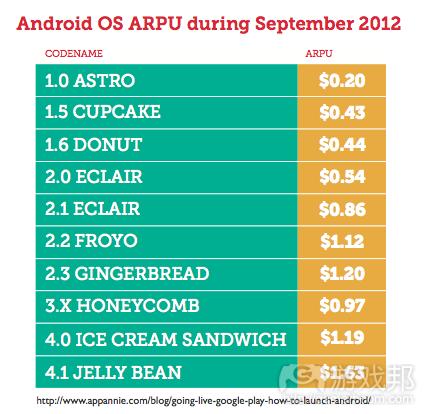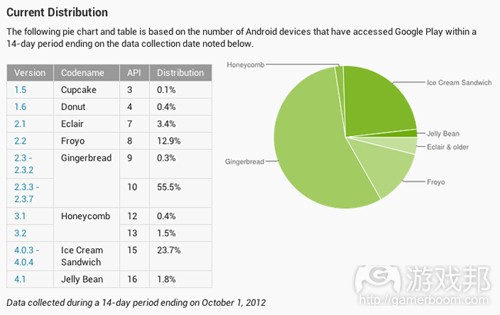每日观察:关注各版本Android用户平均盈利情况(10.25)
1)Tapjoy最新报告指出,谷歌新版Android操作系统Jelly Bean目前每用户平均盈利(ARPU)达1.63美元。
Tapjoy在9月份的调查中发现,除了Honeycomb操作系统之外,每个新版Android操作系统的收益均高于上一版本,旧版Android用户 盈利性普遍低于新版用户。例如,使用Eclair 2.1版本(发布于2010年1月)的ARPU仅为0.86美元,比最新版Android系统用户盈利性少两倍左右。
尽管Gingerbread是最受欢迎的Android操作系统,但由于Android平台分裂性问题,这一版本用户ARPU仅为1.2美元,比采用Jelly Bean的Android用户ARPU低1.8个百分点。
谷歌曾在7月份推出Android平台开发者Kit,以便设备制造商及早升级到最新版操作系统,缓解Android平台分裂性问题。虽然这一举措并未极大提升Android系统更新速度,但自今年夏季以来使用旧版Android系统的用户数量确已明显下降。
在6月份有19.1%的Android用户使用Froyo,但这一数据现在已降至12.9%。Gingerbread覆盖率也从原来的65%降至目前的55.8%;Ice Cream Sandwich自6月份以来增幅极大提升,其用户比例从7.1%显著增长至23.7%,这一版本用户ARPU达1.19美元,接近于Gingerbread用户的水平。
2)据Techcrunch报道,Facebook第三季度移动广告收益约1.5亿美元,在其广告总收益中占比达14%。
Facebook该时期总体广告收益同比上季度增长6.7%,比上年增长32%。
3)eMarketer最新数据显示,美国用户移动设备娱乐内容上的投入时间正不断增长。
平均每个美国人每天使用移动设备上网、运行应用程序、听音乐、玩游戏的时间约82分钟,比2010年时的34分钟增长了51.9%。
但他们今年在传统的非移动设备(例如台式电脑、笔记本电脑、连网电视)投入的上网时间也会有所增长,平均每天为173分钟,但仅比2011年时的167分钟增长3.6%。
4)据venturebeat报道,Zynga首席执行官Mark Pincus日前表示,公司移动游戏业务发展迅速,已占公司总收益的20%。
尽管OMGPOP的收购交易令人失望,但Zynga目前拥有美国第四大移动游戏网络,其产品在前5大热门手机游戏中占据了3个席位。Zynga游戏覆盖了30%的移动用户,其玩家每月游戏时长达100亿分钟。
Zynga计划未来每季度发布2款网页游戏以及4款移动游戏。
5)据insidemobileapps报道,谷歌日前宣布营销人员及广告商现在已能够追踪由AdWords应用内置广告驱动的iOS应用下载量。
他们可通过在自己的AdWords帐号中创建单个代码片段,并将其植入应用中就可以执行这一操作。这样用户每次点击将其导向苹果App Store并下载某款应用的内置广告时,AdWords控制面板都会记录这一下载情况。值得注意的是,这一功能仅用于追踪应用内置广告,而非谷歌搜索或Google Display网络的广告驱动下载量。(本文为游戏邦/gamerboom.com编译,拒绝任何不保留版权的转载,如需转载请联系:游戏邦)
1)Android’s Jelly Bean generates $1.63 ARPU, 35 percent higher than Gingerbread’s $1.20
Kathleen De Vere
Every time Google releases a new version of Android, the platform’s monetization rates improve, reports Tapjoy. According to the company’s latest insights report, the Jelly Bean version of the Android operating system generates $1.63 in average revenue per user (ARPU).
During the month of September, Tapjoy analyzed Android conversion and monetization rates, and found that with the exception of the tablet specific Honeycomb OS, every new version of the Android operating system generated higher ARPU than its predecessor.
For example, Android users with lower end or older devices running outdated versions of the OS don’t monetize very well — Tapjoy reports users still running Eclair 2.1 (released in Jan. 2010) only generate $0.86 in ARPU, but users running the newest versions of Android will monetize at almost twice that rate.
The findings are good news for Android developers, but they also underscore how Android’s fragmentation issues are holding back the monetization potential of the platform.
While Gingerbread may be the most popular version of the Android OS according to Google’s developer dashboard, those users only generate $1.20 in ARPU — 35 percent lower than the $1.63 generated by the 1.8 percent of Android users running Jelly Bean devices.
In June, Google introduced an Android Platform Developers Kit (PDK) in order to address fragmentation issues on the platform by letting OEMs have earlier access to new versions of the Android OS, starting with Jelly Bean. While the move doesn’t seem to have done much to improve new OS adoption speed, the number of users running older versions of Android has has dropped significantly since the summer.
The current Android platform distribution statistics.
Android platform distribution as it looked on June 1, 2012.
In June, 19.1 percent of all Android users were running Froyo, a figure that has since declined to 12.9 percent. Gingerbread has also declined, dropping from 65 percent of all Android devices to its current 55.8 percent share. Ice Cream Sandwich has seen the biggest increase since June, growing from just 7.1 percent of all users to 23.7 percent today. According to Tapjoy, Ice Cream Sandwich users generate an ARPU of $1.19, almost identical to Gingerbread.
Today’s news means that while Android is still fragmented, the older, lower monetizing versions of the OS are seeing their market share decline fairly quickly — a factor that helps explain the significant increases developers have seen in their Google Play revenues and conversions.(source:insidemobileapps)
2)It’s Making The Shift: 14% Of Facebook’s Q3 Ad Revenue Came From Mobile
Josh Constine
Facebook answered the big question of whether it’s transitioning to become a mobile ad company by noting in today’s earnings report that 14% of total ad revenue from Q3 2012 came from mobile — about $150 million.
The older Sponsored Stories and newer non-social app install and Page ads appear to be gaining traction with advertisers. That number will need to grow significantly in future to keep up with the user shift, as mobile monthlies increased 61% year-over-year to 604 million.
Here’s the full audio of the earnings call with Mark Zuckerberg and Sheryl Sandberg:
Total ad revenue was up 6.7% quarter over quarter and 32% year over year. That’s pretty modest recent growth. Considering Facebook wasn’t even showing ads on mobile until the end of February, the total increase from ads on the small screen could have been stronger.(source:techcrunch)
3)The average American consumes 82 minutes of mobile entertainment a day
by Zen Terrelonge
A 51.9 per cent climb on 2010.
New data from eMarketer says consumers in the US are reducing the time spent web browsing via laptops, desktops and connected TVs, which is leading to a spike of mobile entertainment consumption.
The average American is now using their mobile for around 82 minutes a day to browse the web, use apps, listen to music, games and so on, a 51.9 per cent rise from 34 minutes a day in 2010.
That said, traditional non-mobile browsing will still grow this year, but by just 3.6 per cent to 173 minutes a day in comparison to the 7.7 per cent growth in 2011 to 167 minutes per day.(source:mobile-ent)
4)Mobile is now 20 percent of Zynga’s business
Dean Takahashi
Zynga’s mobile gaming business is growing fast and now accounts for 20 percent of its bookings, according to company chief executive Mark Pincus (pictured above) while speaking on a conference call with analysts. Zynga’s stock is rising in after-hours trading thanks to a stock-buyback program and beating analysts’ reduced expectations for the third quarter.
That’s a much larger proportion than in the past, though it is down from the previous quarter because of the rapid decline of Draw Something, the Pictionary-style game that Zynga bought with the $180 million-plus purchase of OMGPOP in the spring. Zynga took a write-off of $95 million related to that acquisition, as the value of OMGPOP has declined to a level beyond what Zynga paid for it.
Despite the big disappointment with the OMGPOP acquisition, Pincus said the social-gaming giant’s fast-growing momentum on mobile is encouraging. Zynga now has the No. 4 mobile gaming network in the U.S., and it has three of the top five mobile games. He said Zynga reaches 30 percent of mobile users, and its players play 10 billion minutes a month of mobile games. At the same time, mobile is a challenge for Zynga because it is a fragmented market and distribution is more limited than on the web.
Zynga expects to launch two web games a quarter and four mobile games a quarter for the foreseeable outlook. Pincus also said that FarmVille and ChefVille are doing well on the web and on Facebook. FarmVille 2 has 61 million monthly active users, including 500,000 who are buying goods in the game for real money. In a single day, players recently spent $950,000 in the game. FarmVille 2 grew to 17 million installations in its first 21 days.
“We had a major breakthrough with FarmVille 2,” he said. “We showed we could bring a major 3D game” to the market. CityVille 2 is also coming soon.
Pincus said the recent acquisition of A Bit Lucky will lead to the company’s entry into the mid-core gaming market — which is in between hardcore console games and casual games — early next year. This could help Zynga reach more traditional hardcore gamers, who spend more money than casual gamers.
Zynga has started bringing more third-party games such as Horn to its mobile network as well as other games to the web-based network. The idea is to reach more genres and more game types faster by leveraging the talent of third-party game developers. Pincus said in the next year that the company will “continue to turn the network conversion on mobile.(source:venturebeat)
5)Google announces tracking for iOS app downloads with AdWords
Scott Reyburn
Google announced today marketers and advertisers can now track iOS app downloads driven by AdWords in-app display campaigns. The Mountain View, Calif.-headquartered corporation added similar tracking functionality for Android apps back in April.
Mobile app marketers can enable iOS app download tracking by creating a single code snippet in their AdWords account and then implementing it into their apps. With the code enabled, every time a user clicks on an in-app display ad that directs them to the iTunes App Store and chooses to download the apps, the download will register within the marketer’s AdWords dashboard. Note that downloads can only be tracked from in-app ads, not Google Search or Google Display network ads.(source:insidemobileapps)















































